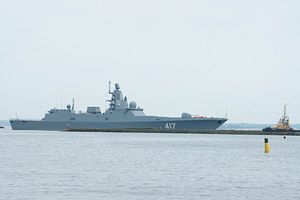The Russian Navy is expected to commission two Admiral Gorshkov-class (Project 22350) guided missile frigates equipped with advanced weapons systems by the end of 2020, Russia’s Defense Minister Sergei Shoigu told Russian media on March 7.
The announcement is yet another confirmation that Russia’s shipbuilding industry is incapable of sticking to the timeline of Russian President Vladimir Putin’s ambitious naval rearmament program.
The Admiral Gorshkov-class program, kicked off in the early 2000s, has faced multiple delays in the last decade. The lead vessel of the class was laid down in 2006, launched in 2010, and has been undergoing builder sea trials since November 2014. It was expected to be handed over to the Russian Navy by November 2016, but technical difficulties with some of the ship’s weapons systems prevented that from happening. (The Russian Navy expects the lead ship of the class to be delivered to the Russian Navy for testing this July.)
This is not surprising. “[A] further delay is likely given that the ship’s air defense systems — the Polimut Redut air defense missile system (Russia’s answer to the U.S. Navy’s Aegis combat system) — has been suffering from some defects,” I reported in August 2016. In his comments to the press, Shoigu did not specify when the Russian Navy is expected to receive a new air defense missile system, merely stating that it will occur in the “imminent future.”
“By late 2020, the Navy will receive two most advanced Project 22350 frigates armed with the Kalibr and Oniks modern strike complexes,” he told reporters in a conference call on March 7. The Kalibr is a supersonic cruise missile available in land-attack, anti-ship, and anti-submarine variants. This missile is nuclear-capable. The P-800 Oniks is over-the-horizon supersonic anti-ship missile with an approximate maximum range of 600 kilometers.
“As a whole, the implementation of these two projects will help develop weapons with unique combat capabilities. The Defense Ministry expects these weapons to be delivered to troops soon,” he added. However, as I pointed out repeatedly, it is not just the Admiral Gorshkov-class’ weapons systems that are responsible for the delay:
Russia no longer has access to Ukraine-made gas turbine engines and is in the process of trying to indigenously produce a propulsion system for its large surface warships. Russia may still have enough engines in stock for the first two Admiral Gorshkov-class and three Grigorovich-class vessels. However, it is unclear how quickly Russia’s shipbuilding industry can design a gas turbine of its own.
Another factor to consider is Russia’s depleted finances. If the defense budgets declines in the coming years, it is likely that funds will be relocated from the surface fleet to the submarine force. Given all current limitations, it remains to be seen whether Russia can fulfill its pledge to introduce 16 Admiral Gorshkov-class guided-missile frigates into the Russian Navy in the near-term future.
































